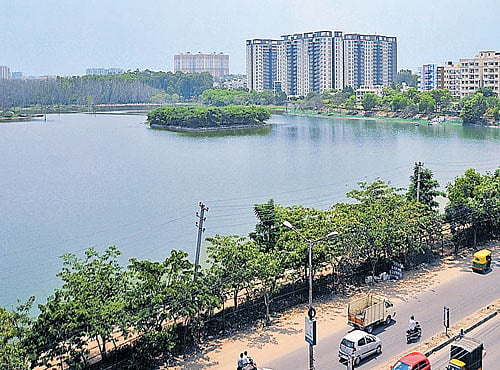
Conservation efforts have been hampered as multiple government agencies are involved in the task; greens cry foul over recreational activities on revived waterbodies
Lakes, once the pride of Bengaluru, are in dire need of rejuvenation. But BBMP has no funds to even take over and maintain the 12 lakes revived by Bangalore Development Authority (BDA) at a cost of Rs. 73.5 crore. Only five of the 38 lakes under the Palike’s possession are in good condition.
Many government agencies are stakeholders in development of lakes. Though funds are reserved for conservation activities, these are always lost in transit. Result: Actual conservation efforts have been hampered.
Priya Ramasubban, founding trustee of MAPSAS (Mahadevapura Parisara Samrakshane Mattu Abhivruddhi Samiti) suggests imposition of a higher property tax on those who have lake frontage, since they are the direct beneficiaries of the water body’s proximity to their homes. The extra percentage paid by these residents should be utilised by the government agency towards development and maintenance of the said lake.
Though Bengaluru still has many good lakes, there is always scope to make it better through citizen’s efforts. Lakes such as the one in Kaikondrahalli on Sarjapura Road and Jakkur lake are classic examples of how citizens' participation has worked well. These lakes have well preserved biodiversity and minimal recreational activities.
However, environmentalists cry foul over activities in lakes such as Nagawara lake, which also houses the Lumbini garden; and boating in Sankey tank and Madivala lake. The experts say that the diesel used in the motor boats affect the lake ecosystem. The smoke and diesel oil leaking into the lake affects not just the aquatic species but also the birds.
Madhuri Subbarao from ‘Friends of Lakes’ says it is very important to conserve the lake as it exists without making any changes in the landscape. “Boating should not be allowed , even walk paths should not be created. Facilities should not be made for people to access the island portion of the lakes. Besides fishery and dairy farming, no other activity must be allowed,” she elaborates.
Dr Harini Nagendra, Professor of Sustainability at Azim Premji University draws attention to cities such as New York, Singapore and Vermont where green ways are carved out of abandoned rail road tracks. These, she says, could serve as inspiration for Bengaluru to create green ways from restored stormwater channels.
According to her, one of the best ways to protect and restore the stormwater channels, which now largely carry sewage, is by removing the concrete and treating the sides by planting reeds and other wetland vegetation that can provide natural bio-remediation.
These restored channels can then be attractively landscaped with cycling and pedestrian pathways to encourage sustainable transport. They could also provide linear corridors and long green parks to be used for exercise and recreation.
She points to Bellandur and Varthur lakes as the city’s worst water bodies, while some of the best restored lakes are Kaikondrahalli lake on Sarjapur road and Puttenahalli lake in JP Nagar. These have been restored and maintained in collaboration with local communities.
S R Nagaraj, technical adviser to CEO of Lake Development Authority, says that a lake becomes good when the groundwater quality improves in the vicinity and it is equipped with proper fencing to avoid encroachment, aquatic species breed and attract birds. “A lake should be a basin for capturing rain water and all lakes must be connected to ensure smooth flow of water from one lake to another. Keeping in mind the current requirement, there should be recreation and walking spaces.”
Since 2008, BDA has been given the task of rejuvenating 117 lakes. Till 2012, the authority has managed to revive 12 lakes at a cost of Rs 73.5 crore and another 17 lakes are to be revived at a cost of Rs 21.5 crore. BDA will be reviving the remaining 88 lakes as and when they receive funds, according to BDA official P N Nayak.
Of the lakes, some of the better ones are in Jakkur, Rachenahalli and Komaghatta. These have well maintained fences and desilted lakebed. The lakes are also equipped with sewage treatment plants to prevent entry of raw sewage.
Yet, most of the city lakes are filled with sewage. Bangalore Water Supply and Sewerage Board (BWSSB) has proposed to set up STPs at 11 locations near the lakes. These are expected to be commissioned only in 2016.
An STP of 90 million litres per day (MLD) capacity is in the pipeline for Bellandur Amani lake. A 20-MLD capacity STP has been proposed at Horamavu Agara.
The Kengeri, Koramangala and Challaghatta Valley is to get an STP of 60 MLD capacity each. For Nagasandra and Doddabele STPs of 20 MLD each are proposed. Others STPs in the list are: Yellamallappachetty 15 MLD, Kadugodi six MLD, Chikkabanavara five MLD and Kachohalli three MLD.